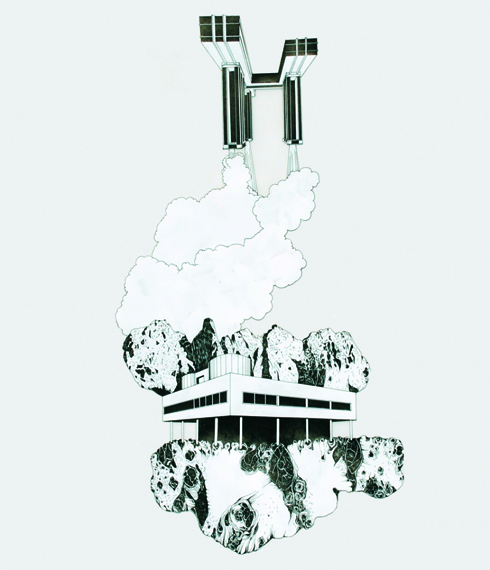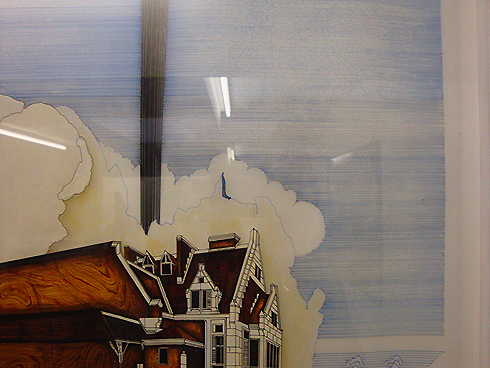A video sketch of the virtual city skyline: it includes several buildings which are landmarks (India Gate and Taj Mahal Palace), or are about to be built (Imperial Towers). Still in the process of illustrating people, details, events, and deciding which parts of the skyline are most symbolic. The sky is in small animated pieces, however am still exploring colours and time of day.
Pier Stockholm
26 NovPier Stockholm: Born in Peru, works and lives in Paris. “Pier Stockholm re-creates chaos in an apparent aesthetically ordered manner” (Julia Van Hagen, ArtStanding. Oct. 2010).
Drawings. Indian Ink & glass paint on paper vegetal. 2008
Visit image source
Detail: Metal by Pier Stockholm.
The theme of chaos vs. order is an important aspect of the Mumbai panorama’s and I intend to explore it in some detail.
Kolkoz
25 NovI saw this work at the ArchiChaos Exhibition in London (14th Oct to 13th Nov, Curated by Julia Van Hagen/Artstanding). “The exhibition ‘ARCHICHAOS’ demonstrates the notion of architecture and chaos. Each artist’s work included in this project reflects upon the notion of architecture, nature and society.”
“Kolkoz Tower, London, Canary Wharf Station View” 2008
Photograph, aluminum, framing / Photographie, aluminium, encadrement
49 1/4 x 67 x 1 1/4 inches / 125 x 172,2 x 3,2 cm
1/5 + 2AP
Courtesy: Galerie Perrotin, Paris
It is also relevant at this point to connect this work with Muybridge’s panorama of San Francisco; which I had mentioned earlier as an important influence in creating a digital panorama of Mumbai.
27th Dec. 2010 Update: Kolkoz uses pieces of photographs to “construct” the blue sky in the above work, which in turn influenced my own practice. I used a similar method to construct a sky with pieces of video footage.
Sally Mackey: Practice as Research
18 NovMy notes from the talk by Sally Mackey :
Key questions: the key questions of your research are a work in progress as you evolve through the project: PROCESS driven. The importance of process (rigor and significance) versus the final product (as in the final product cannot stand on it’s own).
Laboratory : creating a set up to enquire into your key questions.
Dissemination of research: Can an artwork disseminate knowledge (your research) on its own without an abstract? This is especially important in temporary art – or ‘ephemerality of performance’.
Peer Review: The importance of getting published, that is, other people (relevant to the field) should comment on your work, write about it, so that it is acknowledged as practice as research. These are all outcomes, ways to disseminate (DVD, websites, papers, articles, reviews, etc.)
Complimentary Annotation (documentation): Photos, bits of material, video clips, notes, etc.
Camille Utterback
12 NovHer series of intallations called Liquid Time interested me because of the use of videos from urban cities across the world, and how the factor of time changes in relation to the user’s movement around the space. She says:
The interactive medium provides a rich environment to explore the connections between physical bodies and the myriad of representational systems possible in the digital realm. Physical-digital interfaces – ranging from the familiar mouse and keyboard to more unusual sensing systems – provide the connective tissue between our bodies and the codes represented in our machines. I take these interfaces as both a practical and conceptual artistic challenge. Interactive systems determine the grammar of our interaction with digital media, and ultimately its possibility for meaning.
The Elsewhere
10 NovMy aim is to represent the conflict and relationship between the here and the longing for elsewhere through an interactive panorama of Mumbai city. A digital collage of appropriate symbols, popular images and architecture will create two bipolar city landscapes that will interact with each other and the user, creating an experience that emphasizes the difference between a collectively imagined dreamscape versus the ‘reality’ of Mumbai.
The song-site in Bollywood movies is a good example of the imagined elsewhere for middle and upper-middle class Mumbaikars, where we are suddenly transported from the streets of Mumbai or the here, into an ideal place frequently represented by Switzerland, New Zealand or Germany; a dreamscape that is actually being built (Fig.1) through the efforts of architects and builders who have realized and understood this desire amongst aspiring Indians (Ashraf, 2005, p. 68):
The longing for elsewhere is now embodied in new building configurations that are radically altering the urban landscape: malls and shopping centres, cineplexes and flyovers, and exclusive apartment or residential complexes.
Using popular commercial styles of architects such as Hiranandani and Hafeez Contractor, the elsewhere will be a seamless city inspired by exclusive residential complexes and sets from Bollywood movies.
Explication
29 OctOr making the implicit, explicit. That was the goal when writing my plan for phase 1 of the MA project. What I achieved though was a brief overview of the project’s main aims as they stand now, and how I plan to accomplish them within the given time period:
My aim is to create an interactive experience or object that represents a slice of the city Mumbai. Using visual language that symbolically represents the city’s dichotomies and conflicting identities, I propose to explore the city’s depth and complexity through the combined use of an appropriate form language, relevant technology and multimedia.
Download the full PDF here: Study_Plan (2.5 MB)
Exhibition
28 OctMy visit to Tate Britain and the V&A in London was helpful in several ways. First off, Fiona Banner’s work Harriet and Jaguar made a huge impact on me. The fighter jets looked beautiful and awe inspiring, especially because of the way they were placed in the museum gallery. In a way she has transformed them so that it’s difficult to remember that these are deadly machines: war planes used to kill people.
Another image from Fiona Banner called Top Gun (1994), this is a close-up I’ve taken. It interested me because of the way it pulls you in and persuades you to read more.
Inverse Reverse Perverse (1996) by Cerith Wyn Evans at the Tate, London
Inversions (1966) by Mary Martin
Structure 14c (1961) by Stephen Gilbert, at the Tate London.
Of all the work by Eadward Muybridge that was exhibited, Panorama of San Francisco from Street Hill (1878) was the one that came closest to affecting my practice as an artist. The idea of a landscape or panorama of the city of Mumbai had been churning in my head for a while, and experiencing this work at this scale helped me focus on the concept as a method of depicting a rich space. The landscape format reveals more of the city than what is seen normally, or parts of the city like they have never been seen before; a disillusioned and yet enlightened reinterpretation of a physical urban space. I will explore the landscape format in more detail in a later post.
Update (8th Dec): Photo documentation of more exhibitions I’ve visisted here.












